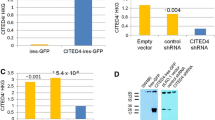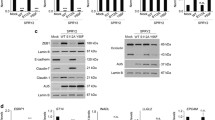Abstract
The inhibition of histone deacetylase activity is known to induce morphological changes of transformed cells. In this study, we investigated the effect of the specific HDAC inhibitor, trichostatin A (TSA), on colon carcinoma cell lines. Treatment of human colorectal carcinoma cells, KM1214 and KM12SM, with TSA induced distinct morphological changes. Both cell lines, which normally piled up in layers without clear boundary, became more flattened, and formed monolayers with evident boundaries between cells, with concomitant increased actin filament organization. Cell–cell interaction was not affected much, based on expression level, membrane localization, and interaction of E-cadherin with β-catenin. In contrast, syndecan-2 expression was dramatically reduced and it was correlated with the morphological changes of colon carcinoma cells. Consistently, downregulation of syndecan-2 expression by antisense cDNA clearly mimicked the morphological changes in KM12SM and reduced anchorage-independent growth of colon cancer cells. All these results indicate that reduced syndecan-2 expression correlates with TSA-induced morphological changes and reduced tumorigenic activity in colon carcinoma cells.




Similar content being viewed by others
References
Bernfield M, Kokenyesi R, Kato M, Hinkes MT, Spring J, Gallo RL and Lose EJ . (1992). Annu. Rev. Cell. Biol., 8, 365–393.
Couchman JR and Woods A . (1999). J. Cell. Sci., 112, 3415–3420.
Cress WD and Seto E . (2000). J. Cell. Phys., 184, 1–16.
Hoshikawa Y, Kwon HJ, Yoshida M, Horinouchi S and Beppu T . (1994). Exp. Cell. Res. 214, 189–197.
Inki P and Jalkanen M . (1996). Ann. Med. 28, 63–67.
Jayson GC, Vives C, Paraskeva C, Schofield K, Coutts J, Fleetwood A and Gallagher JT . (1999). Int. J. Cancer., 82, 298–304.
Kusano Y, Oguri K, Nagayasu Y, Munesue S, Ishihara M, Saiki I, Yonekura H, Yamamoto H and Okayama M . (2000). Exp. Cell. Res., 256, 434–444.
Kwon HJ, Owa T, Hassig CA, Shimada J and Schreiber SL . (1998). Proc. Natl. Acad. Sci. USA, 95, 3356–3361.
Leppa S, Mali M, Miettinen H and Jalkanen M . (1992). Proc. Natl. Acad. Sci. USA. 89, 932–936.
Marks P, Rifkind RA, Richon VM, Breslow R, Miller T and Kelly WK . (2001). Nat. Rev. Cancer, 1, 194–202.
Rachel BH, Greg RP, Rul FQ, Larry N and Stuart AA . (2000). J. Cell. Biol, 148, 779–790.
Rapraeger AC . (2000). J. Cell Biol., 149, 995–998.
Sealy L and Chalkley R . (1978). Cell, 14, 115–121.
Struhl K . (1998). Genes. Dev., 12, 599–606.
Sugita K, Koizumi K and Yoshida H . (1992). Cancer Res., 52, 168–172.
Wiksten JP, Lundin J, Nordling S, Lundin M, Kokkola A and Boguslawski KV . (2001). Int. J. Cancer., 95, 1–6.
Woods A and Couchman JR . (2000). J. Biol. Chem., 275, 24233–24236.
Yoshida M, Kijima M, Akita M and Beppu T . (1990). J. Biol. Chem., 265, 17174–17179.
Zimmermann P and David G . (1999). FASEB J., 13, S91–S100.
Acknowledgements
This work was supported by a research grant of the Ministry of Health and Welfare (HMP-00-B-20800-0080) to ESO, and the Korea Health 21 R&D Project, Ministry of Health and Welfare (HMP-01-PJ1-PG1-01CH04-0005) to HJK. Both Y Lim and H Park were supported by a fellowship from the Brain Korea 21 project.
Author information
Authors and Affiliations
Corresponding author
Rights and permissions
About this article
Cite this article
Kim, Y., Park, H., Lim, Y. et al. Decreased syndecan-2 expression correlates with trichostatin-A induced-morphological changes and reduced tumorigenic activity in colon carcinoma cells. Oncogene 22, 826–830 (2003). https://doi.org/10.1038/sj.onc.1206068
Received:
Revised:
Accepted:
Published:
Issue Date:
DOI: https://doi.org/10.1038/sj.onc.1206068
- Springer Nature Limited
Keywords
This article is cited by
-
Tyrosine 51 residue of the syndecan-2 extracellular domain is involved in the interaction with and activation of pro-matrix metalloproteinase-7
Scientific Reports (2019)
-
PKM2 regulates neural invasion of and predicts poor prognosis for human hilar cholangiocarcinoma
Molecular Cancer (2015)
-
Syndecan-2 promotes perineural invasion and cooperates with K-ras to induce an invasive pancreatic cancer cell phenotype
Molecular Cancer (2012)
-
Expression and prognostic role of syndecan-2 in prostate cancer
Prostate Cancer and Prostatic Diseases (2010)




